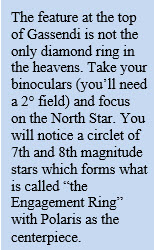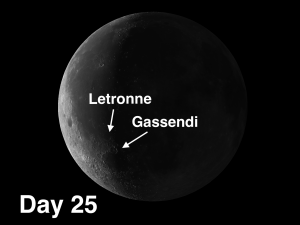The week of November 13-19 takes us from Day 25 into Day 1. On Monday the Moon doesn’t rise until around 2:00 A.M. This week we will highlight the craters Gassendi and Letronne.
 Gassendi: [SW/L5] Three generations of crater age can be easily observed on Mare Humorum. In descending order of age we have Mare Humorum itself1, which is overlapped by the younger crater Gassendi on the north rim, which in turn is overlapped on its north rim by Gassendi A. (Both Gassendis taken together are sometimes referred to as the diamond ring.) The usually dependable rule in play here is that smaller craters are younger (there are some exceptions). The invariably dependable rule is that the topmost overlapping crater is always younger.
Gassendi: [SW/L5] Three generations of crater age can be easily observed on Mare Humorum. In descending order of age we have Mare Humorum itself1, which is overlapped by the younger crater Gassendi on the north rim, which in turn is overlapped on its north rim by Gassendi A. (Both Gassendis taken together are sometimes referred to as the diamond ring.) The usually dependable rule in play here is that smaller craters are younger (there are some exceptions). The invariably dependable rule is that the topmost overlapping crater is always younger.
 Gassendi is a double prize in that it is a floor-fractured crater with a nice set of central mountain peaks, the highest of which rises to 4,000 feet. It is also a textbook example of subsidence2. Notice how there is a small amount of smooth mare inundation near the S.E. portion of the rim.
Gassendi is a double prize in that it is a floor-fractured crater with a nice set of central mountain peaks, the highest of which rises to 4,000 feet. It is also a textbook example of subsidence2. Notice how there is a small amount of smooth mare inundation near the S.E. portion of the rim.
Gassendi is considered to be one of the Moon’s most beautiful and interesting objects. To add to the interest, its floor is crisscrossed by a plethora of rilles (some authorities say there are at least 30). Several rilles in the southeast section can be easily seen with a 4-inch scope. The ones on the eastern half require larger apertures. Draw a map of what you can see, then come back later and try to improve on the count. (See how close you can get to 30.) Because its interior features change noticeably as the Sun rises higher, it is a rare event that any two observers will agree on the number and placement of the rilles. (You will probably discover that you will not agree even with yourself after visiting a few times.)
While you’re in the area of Gassendi, be on the lookout for LTP’s3. Several have been reported here.
Gassendi A: [SW/L6] This is the gemstone in the “diamond ring” mentioned above (the small unnamed crater at the top of Gassendi). Although Gassendi A is much smaller than Gassendi, its walls are one mile higher because it is not a floor-fractured crater (i.e., underlying pressure never caused its floor to rise abnormally, as is the case with Gassendi).
 Letronne: [SW/L5] Notice the similarities between Gassendi and Letronne. They are both examples of subsidence, except that Latronne’s seaward rim has been completely covered by lava–so much so that it looks like a small version of Sinus Iridum [NW/E6] (which was viewable last night). In the very middle of Letronne there is an example of a wrinkle ridge that outlines a ghost crater lying beneath the surface.
Letronne: [SW/L5] Notice the similarities between Gassendi and Letronne. They are both examples of subsidence, except that Latronne’s seaward rim has been completely covered by lava–so much so that it looks like a small version of Sinus Iridum [NW/E6] (which was viewable last night). In the very middle of Letronne there is an example of a wrinkle ridge that outlines a ghost crater lying beneath the surface.
OF ADDITIONAL INTEREST IN SPACE THE WEEK OF NOVEMBER 13-19:
In August 2016, astronomers discovered an Earth-like planet orbiting Proxima Centauri, just 4.25 light-years away. The planet has been labeled Proxima Centauri-b. Because it is in the so-called Goldilocks Zone, it very possibly has water and is potentially habitable! Plans are under way to send a spacecraft to Proxima Centauri-b to check it out. Starshot, a program founded by a Russian billionaire (with backing from Stephen Hawking) intends to launch centimeter-sized nanocraft toward the planet. Incredibly, these craft will be able to reach speeds of 20% of the speed of light and will arrive in a mind-boggling 20 years (as opposed to 165,000 years for today’s traditional spacecraft!). The nanocraft will be powered by sails that will be pushed through space by an array of Earth-based lasers that would deliver 100-billion watts of energy.
1A mare (sea) is nothing more than a large crater that has been filled in with lava.
2Due to dramatic subsidence, the walls of Gassendi slope down from a height of 6,100 ft. to a mere 200 ft. There seems to be one small breach where it looks like the wall has fallen almost to sea level.
3Lunar Transient Phenomena
======================
It is highly recommended that you get a copy of Sky and Telescope’s Field Map of the Moon, the very finest Moon map available for use at the telescope. It is available for $10.95 at www.skyandtelescope.com and on Amazon. All features mentioned in this blog will be keyed to the grid on the Field Map and will look like this: Plato: [NW/D9]
Credits:
Courtesy of Gray Photography of Corpus Christi, Texas
Lunar photos: NASA / USGS / BMDO / LROC / ASU / DLR / LOLA / Moon Globe. Used by permission
- Rupes Cauchy: A Best Known Fault on the Moon - July 22, 2024
- Moon Crater Schickard – Crater Floor has Stripes - July 15, 2024
- Moon Craters Langrenus and Vandelinus - July 8, 2024
